Clean and fresh in a single swipe - Wet wipes, the ultimate hygiene guide!
Wet wipes are a versatile and convenient product that has become a household and business staple. These pre-moistened, disposable towelettes are made of soft, nonwoven material that is gentle on the skin and can be used for a wide range of purposes. From personal hygiene to تنظيف and disinfecting surfaces, wet wipes have endless applications in daily life.
Whether it's wiping away makeup or refreshing after a workout, wet wipes are perfect for quick cleanups on-the-go. They are also commonly used in industries such as baby care, personal care, pet care, household cleaning, industry cleaing and hospitality to maintain high standards of hygiene and sanitation.
With their convenience and versatility, wet wipes have earned their place as an essential item in many people's lives. From small travel-sized packs to larger canisters and tubs for home use, wet wipes are available in different sizes and types to meet different needs. So why not make wet wipes a part of your daily routine and enjoy their benefits for yourself?

بعض العوامل التي يجب عليك مراعاتها إذا كنت تخطط لإنشاء علامة تجارية للمناديل المبللة
سبونليس محبوكة
عند تطوير أ مناديل مبللة العلامة التجارية، واختيار القماش غير المنسوج المناسب أمر ضروري. يعد القماش غير المنسوج Spunlace خيارًا شائعًا نظرًا لنعومته وقوته وامتصاصه. إنه لطيف على البشرة، قوي بما يكفي لتحمل المسح المتكرر، وعالي الامتصاص، مما يجعله خيارًا فعالاً للمناديل المبللة. بل هو أيضا قابلة للتحلل وصديقة للبيئة، وهو أمر ذو أهمية متزايدة للمستهلكين المهتمين بالبيئة. عند اختيار قماش غير منسوج، لا تأخذ في الاعتبار فقط نوعه النعومة والقوة والامتصاص، بل أيضًا السلامة والأثر البيئي. يمكن أن يساعد استخدام الأقمشة غير المنسوجة المصنوعة من مادة سبونليس في إنشاء مناديل مبللة فعالة وآمنة وصديقة للبيئة تلبي احتياجات جمهورك المستهدف. في النهاية، يمكن للقماش غير المنسوج المناسب أن يحدث فرقًا كبيرًا في إنشاء علامة تجارية ناجحة للمناديل المبللة.
| حدود | اقتراحنا |
|---|---|
| الفيبر | مزيج مخصص من البوليستر/الفيسكوز/الخيزران 20%-100% فيسكوز |
| جراماج | 30-100 جم |
| نمط | شبكة، عادي، منقوش، نقطة كبيرة، نقطة صغيرة |


الأفضل فقط لبشرتك - الماء النقي في كل منديل
عند إنتاج مناديل مبللة، تستخدم QIMEI الماء النقي لضمان خلو المناديل من الشوائب التي قد تسبب تهيج الجلد أو مشاكل أخرى. المياه النقية هي المياه التي خضعت لعملية ترشيح لإزالة الشوائب مثل المواد الكيميائية والمعادن والكائنات الحية الدقيقة.
يعد استخدام المياه النقية أمرًا مهمًا للحفاظ على جودة وسلامة المناديل المبللة، حيث قد يحتوي ماء الصنبور على مواد كيميائية أو معادن يمكن أن تؤثر على فعالية المناديل أو تسبب تهيج الجلد. بالإضافة إلى ذلك، يساعد استخدام الماء النقي على إطالة العمر الافتراضي للمناديل عن طريق تقليل خطر نمو البكتيريا أو التلوث.
في QIMEI، نستخدم نظام المياه عالي النقاء EDI للتأكد من أنقى مياه لكل قطعة مناديل.
الصياغة
باعتبارها شركة مصنعة للمناديل المبللة، فإن شركة Qimei لديها القدرة على تطوير تركيبات مخصصة للعملاء وفقًا لاحتياجاتهم احتياجات ومتطلبات محددة. نحن ندرك أن العملاء المختلفين قد يكون لديهم تفضيلات أو متطلبات فريدة للمناديل المبللة الخاصة بهم، ولهذا السبب نقدم المرونة اللازمة لإنشاء تركيبات مصممة خصيصًا لتلبية احتياجاتهم.
يتمتع فريقنا من المحترفين ذوي الخبرة بالخبرة اللازمة لتطوير تركيبات فعالة وآمنة تلبي معايير الصناعة أو تتجاوزها. نحن نختار بعناية مكونات عالية الجودة ونجري اختبارات صارمة للتأكد من أن تركيباتنا آمنة وفعالة وتلبي توقعات عملائنا.
بالإضافة إلى إنشاء تركيبات مخصصة لعملائنا، فإننا نقدم أيضًا خيارًا لذلك تصنيع مناديل مبللة باستخدام تركيبات عملائنا الخاصة. يتيح ذلك للشركات الحفاظ على سيطرتها على تركيبة منتجاتها والتأكد من أنها تلبي احتياجاتها وتفضيلاتها المحددة.



مواد تعبئة المناديل المبللة
في Qimei، ندرك أن تعبئة المناديل المبللة لا تقل أهمية عن جودة المناديل المبللة نفسها. ولهذا السبب نقدم مجموعة من مواد التعبئة والتغليف المصممة للحفاظ على المناديل المبللة طازجة ومحمية.
مواد التعبئة والتغليف لدينا مصنوعة من مواد آمنة ومتينة وصديقة للبيئة، وهي متوفرة في مجموعة متنوعة من الأحجام والأنماط لتلبية الاحتياجات الفريدة لعملائنا. نحن نقدم أنواعًا مختلفة من مواد التغليف للاختيار من بينها، بما في ذلك:
-
حزم التدفق القابلة للإغلاق: العبوات التدفقية هي الخيار الأكثر شيوعًا للمناديل المبللة، ويتم إغلاقها بملصق / غطاء بلاستيكي (غطاء/غطاء)، لأنها تتيح سهولة الوصول وتساعد في الحفاظ على المناديل منعشة ورطبة. نحن نقدم أحجام وأشكال مختلفة من حزم التدفق القابلة للإغلاق لتلبية الاحتياجات المختلفة.
-
العلب: تعتبر العلب خيارًا شائعًا آخر للتعبئة، لأنها توفر طريقة مريحة وصحية لتخزين وتوزيع المناديل المبللة. عبواتنا مصنوعة من مواد عالية الجودة مقاومة للرطوبة والعوامل البيئية الأخرى.
- صندوق: توفر عبوة الصندوق حاوية أكثر ثباتًا وثباتًا للمناديل المبللة، مما يجعلها مثالية للاستخدام في المنازل أو المكاتب أو غيرها من الأماكن التي قد تكون هناك حاجة إلى مناديل مبللة متعددة. ويمكن أيضًا إعادة تعبئة الصندوق بسهولة، مما يقلل من النفايات ويوفر حلاً فعالاً من حيث التكلفة.
- التعبئة دلو: هو تنسيق أكبر يمكنه استيعاب المزيد من المناديل المبللة، مما يجعله مناسبًا للمناطق ذات حركة المرور العالية أو المواقف التي تتطلب التنظيف المتكرر. يساعد الختم المحكم للدلو على الحفاظ على رطوبة المناديل ويمنع التلوث، مما يجعله خيارًا مثاليًا للاستخدام الصناعي أو التجاري.
-
أكياس: للاستخدام أثناء التنقل، تعد الأكياس خيارًا مناسبًا يمكن وضعها بسهولة في المحفظة أو الجيب. أكياسنا مصنوعة من مواد خفيفة الوزن يسهل فتحها والتخلص منها.
جميع مواد التعبئة والتغليف لدينا قابلة للتخصيص لتلبية الاحتياجات المحددة لعملائنا، بما في ذلك العلامات التجارية، وفيلم التعبئة والتغليف مغلفة، ووضع العلامات، وغطاء / غطاء من البلاستيك وخيارات التخصيص الأخرى. نحن نعمل بشكل وثيق مع عملائنا للتأكد من أن عبواتهم ليست عملية فحسب، بل تتوافق أيضًا مع علامتهم التجارية وأهدافهم التسويقية.
Frequently Asked Question - Wet Wipes Raw Material
Which type of spunlace nonwoven is best for wet wipes?
What is flushable wipes made of?
How long do wipes take to decompose?
What is the main ingredient in wet wipes?
What preservative is in wet wipes?
What is biodegradable wipes made of?
Which type of spunlace nonwoven is best for wet wipes?
When it comes to choosing the best spunlace nonwoven fabric for wet wipes, there are several options available, each with unique qualities. The type of spunlace nonwoven you choose will depend on the specific needs of your product and its intended use.
For example, if you're creating a baby wipe, a cotton-based spunlace nonwoven fabric would be an excellent choice. This type of fabric is super soft, highly absorbent, and gentle on delicate skin.
On the other hand, if you're creating a cleaning wipe, you might opt for a spunlace nonwoven made from a blend of polyester and wood pulp. This type of fabric is strong, durable, and perfect for tackling tough messes.
If you're making a facial wipe or beauty product, a viscose and polyester blend would be an excellent choice. This type of fabric has a luxurious, silky feel that is gentle on the skin.
And if you're looking to create an eco-friendly wet wipe, a spunlace nonwoven made from bamboo fibers would be a great choice. Not only is it biodegradable, but it's also soft, strong, and absorbent.
Ultimately, the key to choosing the best spunlace nonwoven for your wet wipes is to consider the specific needs of your product and select a fabric that will deliver the desired results.
What is flushable wipes made of?
Flushable wipes are made of a combination of materials, which typically include a blend of cellulose fibers, synthetic fibers, and binding agents. The exact composition can vary depending on the manufacturer and the intended use of the wipes.
The outer layer of flushable wipes is typically made from a spunlace nonwoven fabric, which is a strong and durable material that can withstand exposure to water without breaking down.
The inner layer of flushable wipes contains the cleaning solution, which is typically a combination of water, detergents, preservatives, and other ingredients that are formulated to be gentle on the skin.
In addition, many flushable wipes are treated with special additives that help to break down the wipes when they are flushed, making them more environmentally friendly.
It's important to note that not all wipes marketed as "flushable" are actually safe to flush. In some cases, these wipes can cause blockages in plumbing systems and contribute to environmental pollution. As such, it's important to follow the manufacturer's instructions carefully and only flush wipes that are specifically labeled as safe to flush.
How long do wipes take to decompose?
The time it takes for wipes to decompose can vary depending on a number of factors, including the type of wipe, the materials it's made from, and the conditions in which it's disposed of.
In general, most traditional wipes, including those made from plastic fibers or cotton, can take several years or even decades to decompose in a landfill. This is because they are not biodegradable and do not easily break down in the presence of oxygen, sunlight, or other natural elements.
Flushable wipes, on the other hand, are designed to break down more quickly and easily when disposed of in water. However, even flushable wipes can take some time to fully decompose and can contribute to blockages in sewer systems and water treatment plants.
To minimize the environmental impact of wipes, it's important to dispose of them properly, following the instructions on the packaging. In general, it's best to avoid flushing any type of wipe down the toilet and instead dispose of them in the trash.
What is the main ingredient in wet wipes?
The main ingredient in wet wipes is the wiping solution, which is typically a combination of water, cleaning agents, preservatives, and other additives. The exact composition of the wiping solution can vary depending on the intended use of the wipes.
Water is typically the primary ingredient in the wiping solution, serving as a carrier for the other ingredients and providing moisture to help clean and refresh the skin. Cleaning agents, such as detergents and surfactants, help to remove dirt, oil, and other impurities from the skin.
Preservatives, such as benzalkonium chloride or phenoxyethanol, are added to wet wipes to prevent the growth of bacteria and mold, which can cause the wipes to spoil or become contaminated over time.
Other ingredients, such as fragrances, moisturizers, and skin-conditioning agents, may also be added to wet wipes to enhance their cleaning and refreshing properties and improve the user's experience.
It's important to note that some people may be sensitive to certain ingredients in wet wipes, such as fragrances or preservatives, and may experience skin irritation or allergic reactions as a result. If you experience any adverse reactions while using wet wipes, it's best to discontinue use and consult with a healthcare provider.
What preservative is in wet wipes?
There are several different preservatives that can be used in wet wipes to prevent the growth of bacteria, fungi, and other microorganisms that can cause spoilage or contamination over time. Some common preservatives found in wet wipes include:
-
Benzalkonium chloride: This is a quaternary ammonium compound that is effective against a wide range of microorganisms. It is commonly used in disinfectant wipes and other cleaning products.
-
Phenoxyethanol: This is a glycol ether that is effective against both bacteria and fungi. It is commonly used in personal care products such as wet wipes, shampoos, and lotions.
-
Methylisothiazolinone (MIT): This is a synthetic compound that is effective against bacteria and fungi. It is commonly used in personal care products and household cleaning products.
-
Chlorhexidine: This is a disinfectant and antiseptic agent that is effective against a wide range of microorganisms. It is commonly used in healthcare settings and in personal care products such as wet wipes.
The choice of preservative used in wet wipes can depend on a variety of factors, including the intended use of the wipes, the pH of the wiping solution, and the desired shelf life of the product. It's important to note that some people may be sensitive to certain preservatives, and may experience skin irritation or allergic reactions as a result.
What is biodegradable wipes made of?
Biodegradable wipes are made of materials that are capable of breaking down naturally in the environment, typically through microbial or enzymatic action. The specific materials used in biodegradable wipes can vary depending on the brand and the intended use of the wipes, but some common materials include:
-
Cellulose: This is a natural polymer that is derived from plants, and is commonly used in biodegradable wipes as a sustainable alternative to synthetic materials.
-
Bamboo: This is another natural material that is commonly used in biodegradable wipes due to its sustainability and biodegradability.
-
Cotton: This is a natural fiber that is often used in biodegradable wipes due to its softness and absorbency.
-
Rayon: This is a synthetic fiber that is derived from plant materials, and is sometimes used in biodegradable wipes as a more eco-friendly alternative to other synthetic materials.
In addition to the materials used in the wipes themselves, biodegradable wipes may also use environmentally friendly ingredients in their cleaning solutions, such as plant-based surfactants and natural fragrances. The goal of biodegradable wipes is to provide a more sustainable and eco-friendly alternative to traditional wipes, while still providing effective cleaning and refreshing properties.
